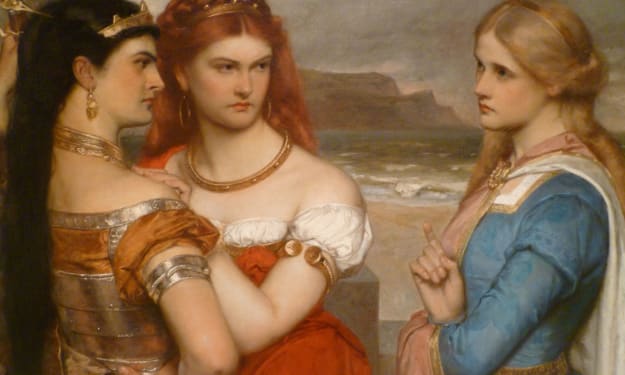
Once Upon a Time, in a city in the English Midlands, there lived a man named Philip Blue who was very rich and who owned a factory. Some years before he had invented a new kind of widget, and he built his factory so that he could make lots of his widgets and sell them at a very good profit.
As a result he made himself a fortune, but he suffered from a fault that is common to many rich people, which is that his only aim in life became to make yet more money, even though he had long ago reached the point where he had more than enough to last him for the rest of his life. Every day he would visit the vault in the cellar of his enormous house and watch as barrow-loads of money were wheeled in to add to his millions. The only time he spent any of his money was when he wanted to buy another luxury yacht, of which he had several.
He was what is known as a capitalist, but he was one of those who spent so much time adding to his riches that he had no time in which to do anything else, such as washing. That was why his neighbours called him a filthy capitalist. This qualified him to be knighted by the Queen, so that he could call himself Sir Philip Blue.
Of course, he did not make all the widgets by himself. His factory was staffed by a hundred workers who spent all day earning the minimum wage as they turned the wheels on the hundred widget-making machines that produced thousands of widgets every hour.
Sir Philip liked nothing better than to walk through his factory watching his hundred workers turn their wheels and make his widgets. He noted which ones worked faster and which worked slower. He would hurl insults at the really slow ones and call them rude names. Given that he thought that nearly all of them were lazy shirkers, he shouted lots of rude names as he walked through his factory.
There was only one worker who really impressed Sir Philip. This was Number 42, who turned his wheel so fast that he produced twice as many widgets as anybody else. Number 42 was never shouted at or called a rude name. Sir Philip would have loved it if all his workers had been as efficient as Number 42.
One day, as Sir Philip was crossing the road outside his factory, he spotted one of his factory lorries coming down the road. To his horror, he saw that there was nobody driving it. Somebody must have left the handbrake off and let it roll out of the factory gate and onto the public road. The lorry was approaching a pedestrian crossing just as a young woman pushing a pram was using it.
One thought flashed through Sir Philip’s mind. If the lorry was to run down and kill a young mother and her baby, the reputation of his company could he tarnished for ever. He simply could not let that happen. That was why he seized hold of the handle on the driver’s door, pulled it open and leaped aboard, grabbing the handbrake just in time to prevent the lorry, emblazoned with his company’s name and logo, crushing the young woman and the pram beneath its wheels.
The young woman was extremely grateful to Sir Philip for saving her life and that of her baby. Completely misinterpreting his motives, she hugged him tight and asked what she could possibly do to repay him for his brave and thoughtless action.
“You see”, she said, “I’m a fairy and I can grant any wish you might have – anything at all.”
“Anything?” asked Sir Philip.
“Anything”, said the fairy, whose name was Amelia.
“Well,” said Sir Philip, “My deepest wish is that all my hundred workers could be just like Number 42. Could you manage that?”
“No problem”, said Amelia. “Just get me a sample of Number 42’s DNA and I’ll produce 99 clones of him who will work just as hard as he does.”
“That’s brilliant”, said Sir Philip. “But how do I get a sample of his DNA?”
“All you have to do”, said Amelia, “is get a smear of saliva from something he has been drinking out of, such as a cup or a mug. Just collect one the next time he has a tea break.”
“Tea break?” asked Sir Philip. “What’s a tea break?”
Nevertheless, Sir Philip was able to get a DNA sample from Number 42 and the fairy duly produced 99 clones of him. Sir Philip promptly sacked all the other workers and installed the clones in their places.
Production went through the roof. Widgets poured out of the factory, all to the same extremely high standard that Number 42 had always produced. Likewise, more money poured into Sir Philip’s basement and he ordered another two luxury yachts.
But then, a month or so later, Sir Philip noticed that production was starting to slow down. On his next factory visit he went straight to the machine worked by Number 42 and was shocked to see that his star worker was turning his wheel far more slowly than usual, and he looked distinctly unwell.
“I’m very sorry, Sir Philip”, he said. “But I’m going to have to stop working for you. You see, all my family suffer from a very rare genetic disease that means that we have perfectly healthy lives to the age of 50 then drop dead shortly afterwards. It was my 50th birthday last week and my time is nearly up”.
And so it was. Unfortunately for Sir Philip, that was also the case with every other worker in his factory, each of whom was an exact clone of Number 42 and therefore had the same genetic malfunction. Two weeks later, every worker in his factory died and the wheels stopped turning.
Things only got worse. With such a terrible reputation for worker fatalities, nobody would risk taking a job at Sir Philip’s factory. Not only that, but all the original workers, Numbers 1 to 41 and 43 to 100, hired a very clever lawyer who urged them to sue Sir Philip for unfair dismissal and claim massive compensation for all the insults they had suffered at his hands during the time they had worked for him.
Before long, the barrows were wheeling money out of Sir Philip’s cellar, all the yachts were sold, as well as the house, and Sir Philip lost his knighthood.
On the other hand, the 99 former workers, as well as fairy Amelia and her baby, all lived happily ever after.
About the Creator
John Welford
I am a retired librarian, having spent most of my career in academic and industrial libraries.
I write on a number of subjects and also write stories as a member of the "Hinckley Scribblers".






Comments
There are no comments for this story
Be the first to respond and start the conversation.